
One month of Zwift on a cheap stationary bike
11 min read May 17, 2022
For most of my adult life, I’ve considered myself a runner. I found running challenging but rewarding. Running pace was perfect for exploring new cities. I also found that training for marathons made me calm and focused. Then, the injuries started.
The first few were easy to resolve with stretches. Then, a bone injury stopped me from running for an entire year. I bounced back but developed severe pain in one of my feet and stopped again. I was starting to lose confidence that I could run for the rest of my life. As I was in and out of physical therapy, I looked for a replacement activity.
Runners in my life suggested cycling to stay in shape during recovery. I wasn’t interested.
Cycling felt antithetical to the minimalism of running. Biking requires more money and time and is more dangerous than running. Of course, I couldn’t do nothing. I was already feeling the adverse effects of no exercise.
Others in my life suggested Peloton. They raved about it. I, again, wasn’t interested. I was attached to the feeling of traveling around the world under my own power.
That’s when I heard of Zwift, a virtual fitness app.
Free month of Zwift
If you are interested in trying Zwift, use this link to get a free month of Zwift and give me a free month as well.
How Zwift works
Zwift offers cyclists and runners a virtual multiplayer world to train, race, and explore in. I’ll focus on cycling for the rest of this post.
In Zwift, a three-dimensional avatar represents each player. The appearance and performance of my avatar are derived from my real-world height, weight, and performance. As I pedal in the real world, my avatar does the same. I can explore Zwift’s worlds, compete with others, go on group rides, and train, just like in the real world.
Before we continue, let’s define some terms. First, speed describes a distance per unit of time. In a bike, the speed at which we go forward is directly tied to the speed that our bicycle wheels turn. Cadence measures the rate that we are pedaling at.
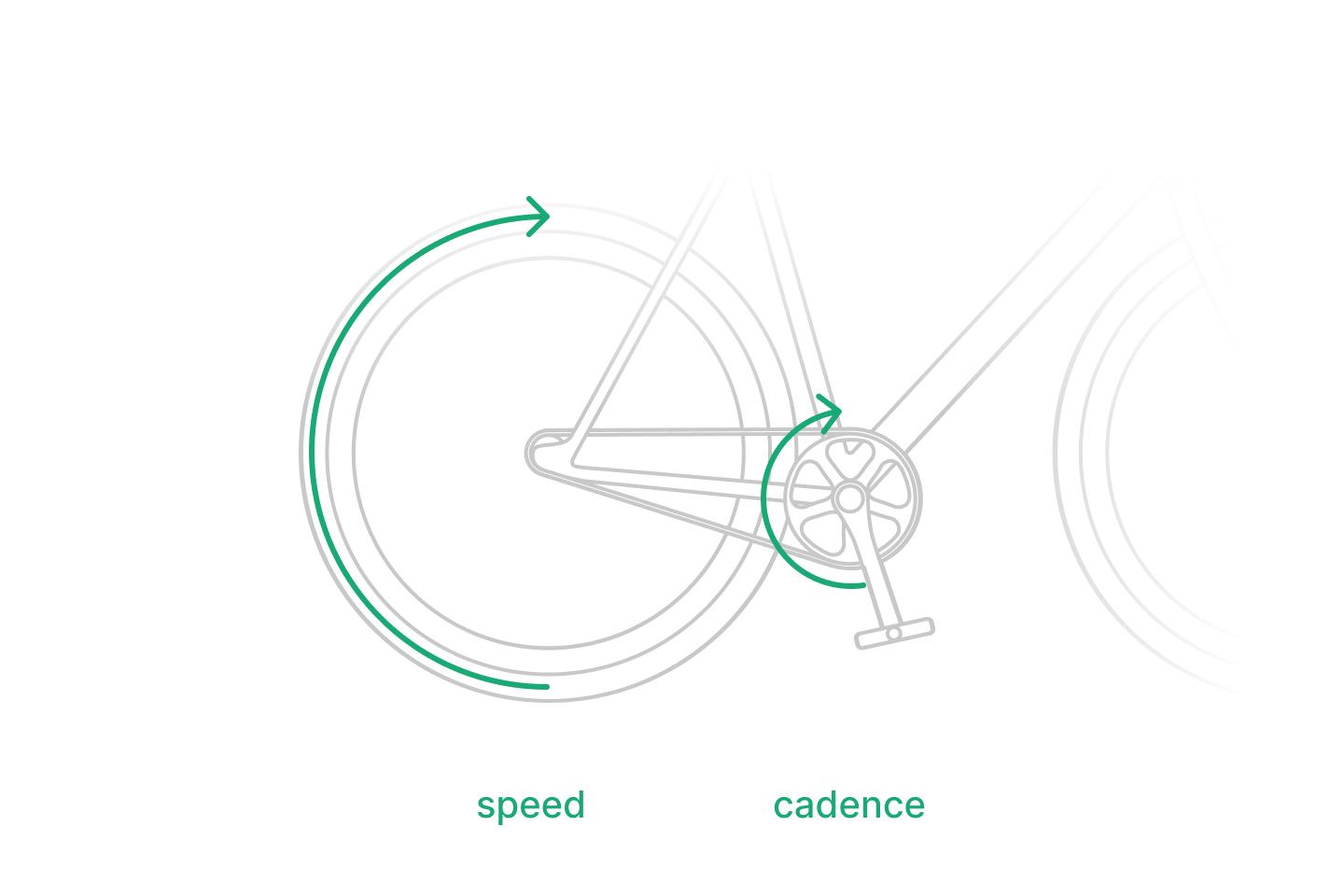
In most bikes, we have shifters that let us change gear ratios. These gear ratios adjust the relationship between our cadence and wheel speed. We generally need to shift when the grade (steepness of the terrain) changes.
The basic Zwift setup is comprised of three components.
- A bike: We need a bike to sit and pedal on. We’ll discuss some of the specific options later on.
- A smart trainer: A trainer allows an outdoor bike to be converted into a stationary bike and provides variable resistance. What makes it smart is the electronics that connect to Zwift.
- A Zwift device: This can be a phone, tablet, computer, or smart TV that renders the Zwift world and menus.
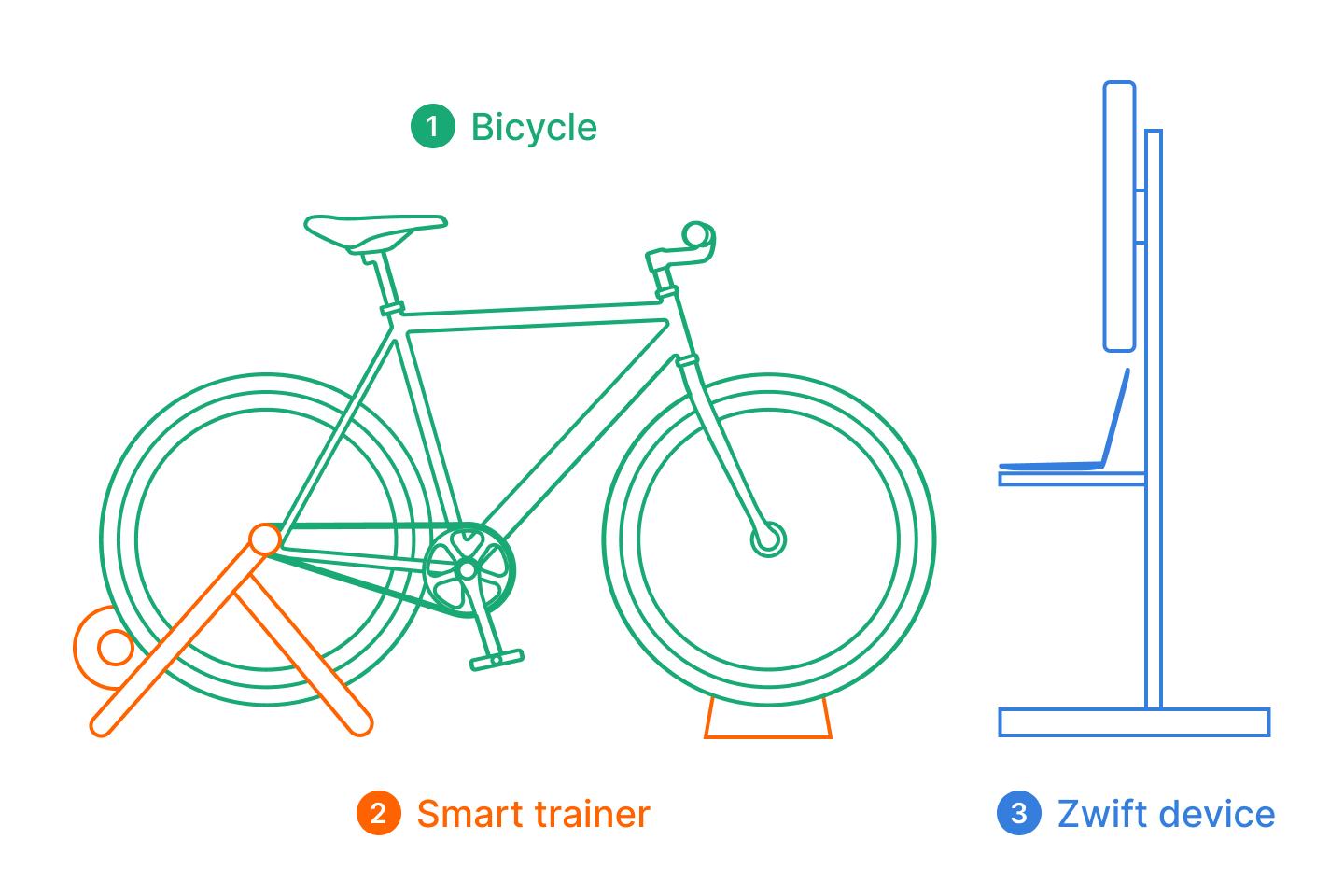
When biking, Zwift directly adjusts the smart trainer’s resistance and reads back speed. Optional heart rate monitors and cadence sensors provide more data that Zwift can use in training modes save alongside other information it collects like power, virtual GPS coordinates, etc.
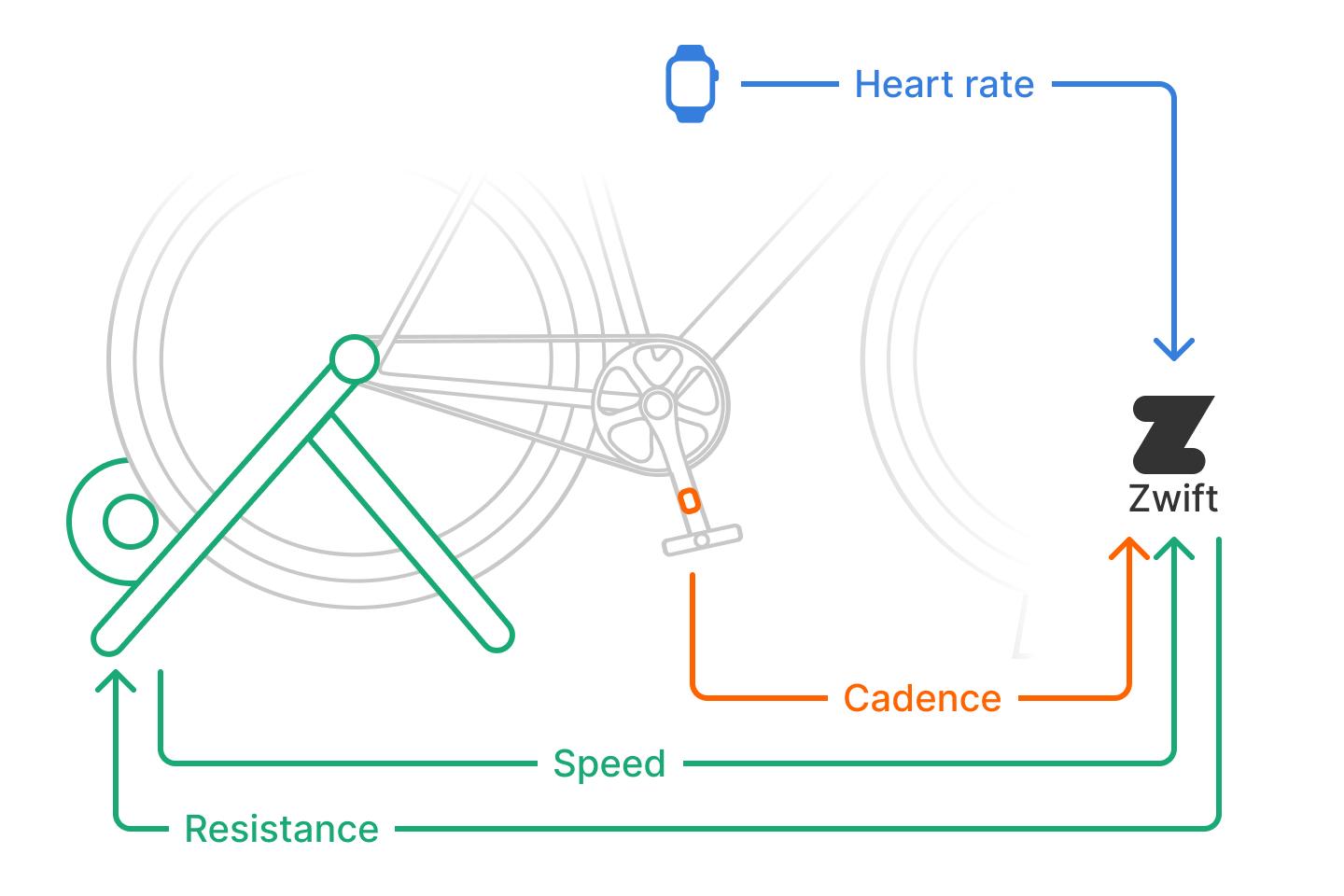
As a rider goes over the virtual terrain, Zwift calculates the correct resistance using their weight and adjusts the trainer. So, a heavier person will experience more resistance going up a given hill, just like in real life.
Zwift connects to Strava, Garmin, and other services for planning and tracking. My Zwift rides show up in Strava alongside my real-world activities.
In addition to the essential elements, the following optional items can improve the riding experience.
- Heart rate monitors record heart rate.
- Cadence sensors record cadence.
- Fans can keep you cool, especially on longer rides.
- A stand can hold keyboards, remotes, snacks, and water.
- A cover can protect the bike or other moving parts from corrosive sweat.
- The Zwift companion app on a mobile phone acts like a bike computer and Zwift remote.
Zwift setups
Check out Zwift’s documentation for the latest list of support devices.
Wheel-on smart trainer
For those with existing road bikes, the simplest and cheapest way to get started with Zwift is to attach your bike to a wheel-on smart trainer.
In this setup, the rear wheel is placed on the smart trainer, which then connects to the Zwift device. The bike can be quickly removed to ride outside. One downside is these trainers do wear down rear tires, which can be mitigated with dedicated indoor tires. Also, the wheel can slip when the rider is pedaling very hard.
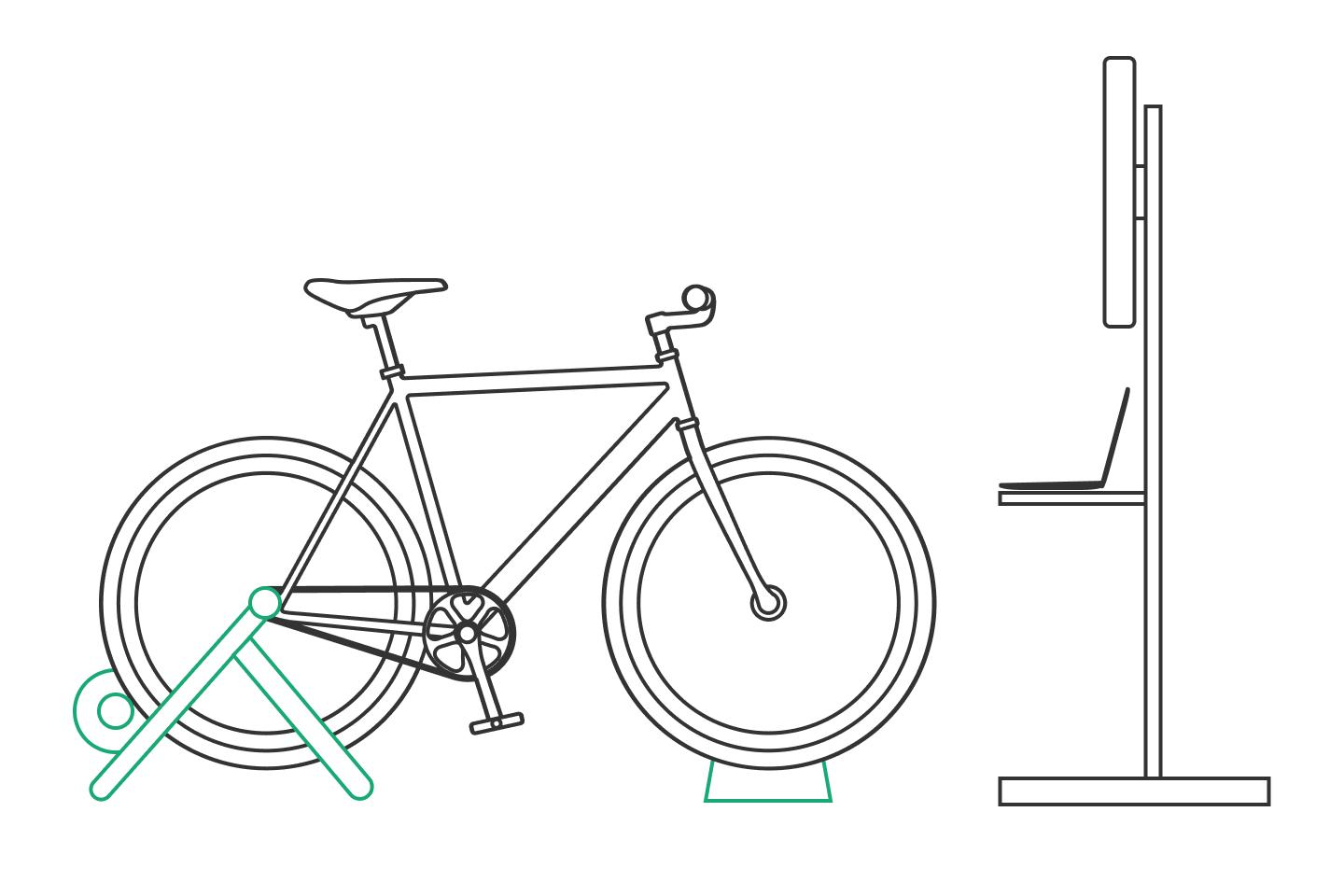
Direct-drive smart trainer
Another more expensive option is the direct-drive smart trainer. These replace the back wheel and cassette. These trainers offer higher resistance ranges and no wheel slippage since the rear axle directly connects to the trainer. They are more expensive than wheel-on trainers and must be configured with a fitting cassette and axle. Their larger size makes them less suited to compact spaces. Also, it will take longer to remove the bike to ride outdoors.
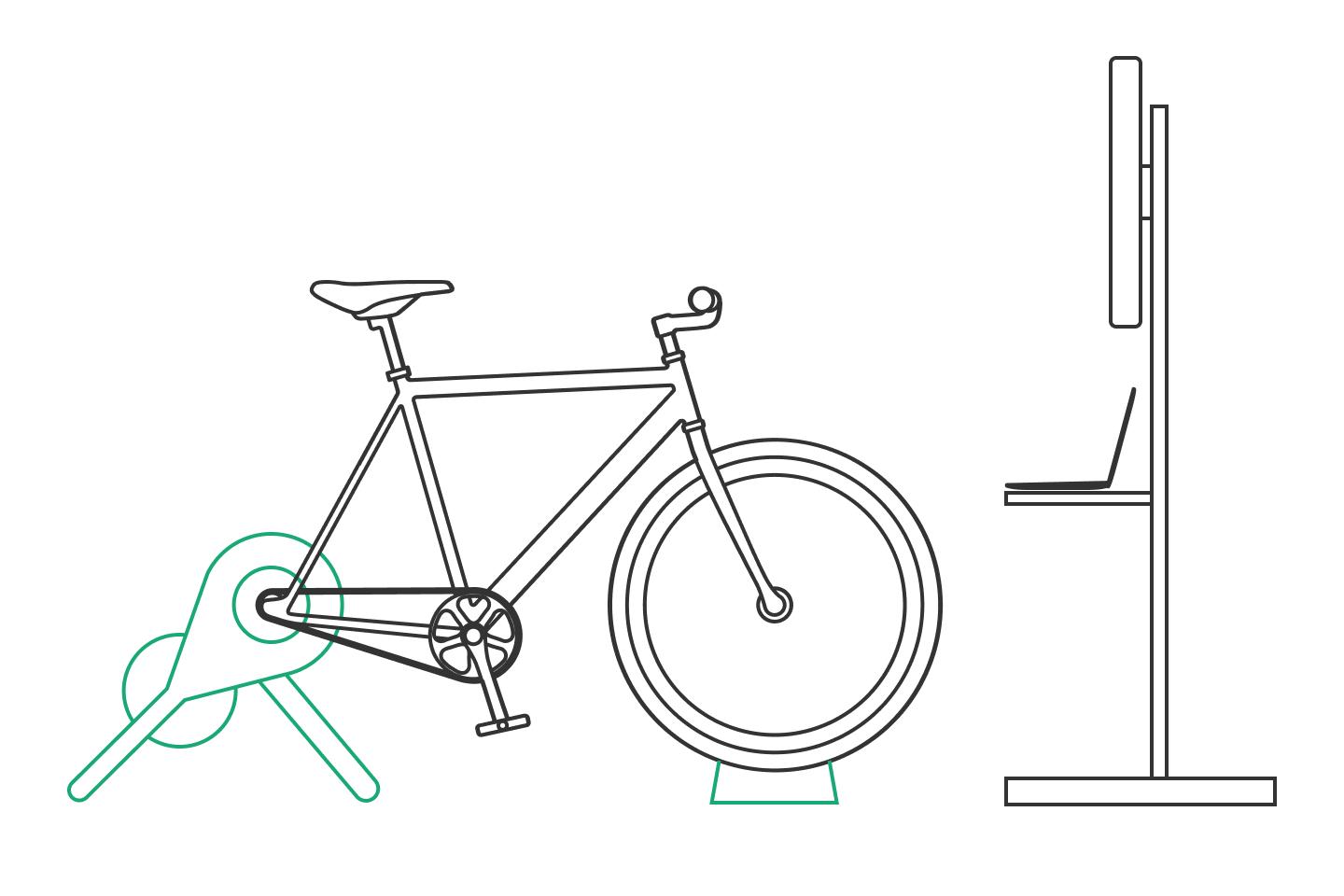
Smart stationary bike
Another approach for Zwift is a smart stationary bike. They are simple. You only need to assemble the bike, connect it to power, and connect it to Zwift. There, again, is a range of options and prices. More complex models can include steering, built-in fans, chargers for devices, and tilt to simulate hill climbs and descents.
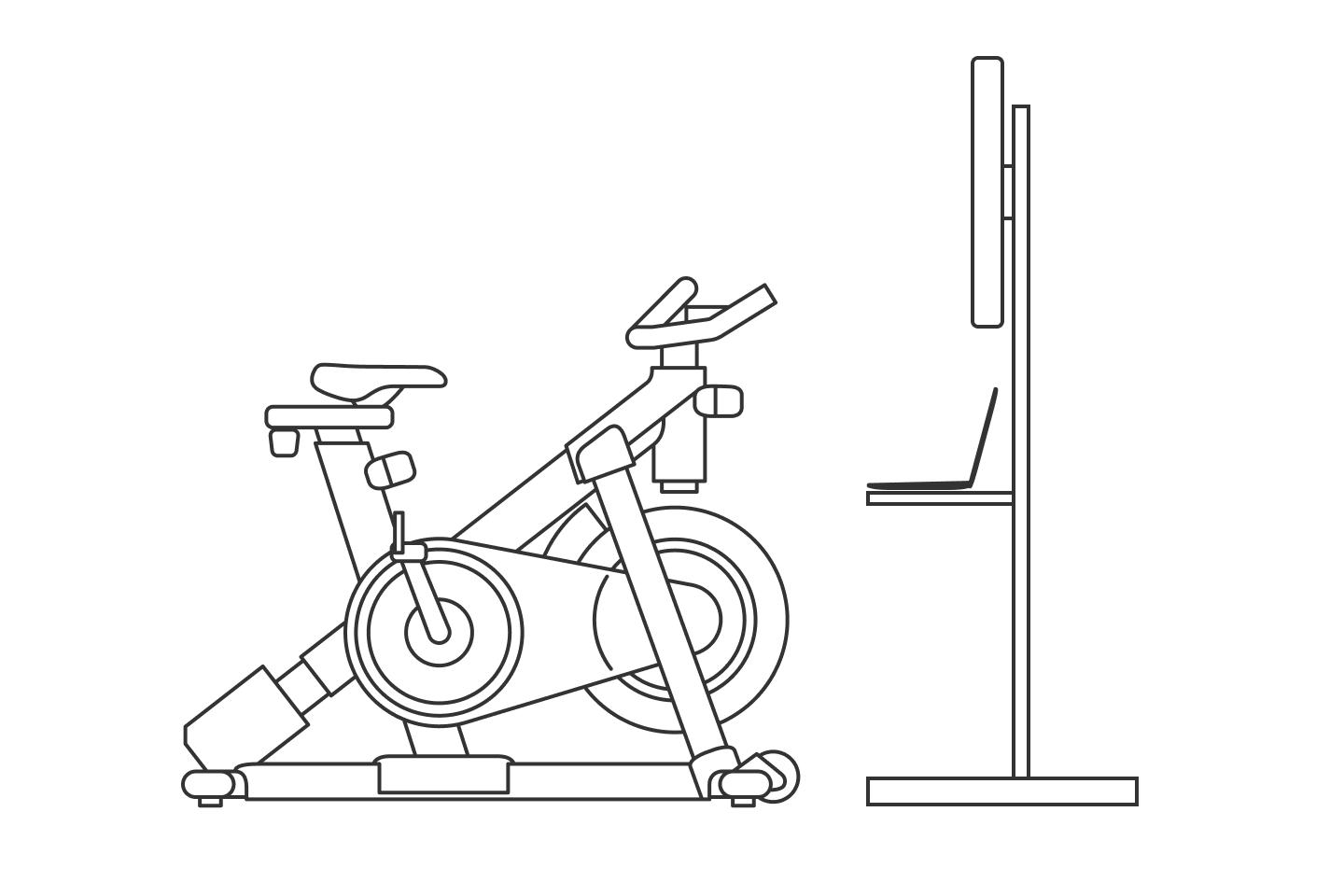
My setup
I spent a few weeks exploring various options, perusing my local classifieds, and reading other riders’ experiences. Then, a question started to dawn on me. Will I even like indoor biking?
So, instead of jumping into the deep end and buying an expensive setup, I set out with an incremental level-by-level approach.
Level one
In level one, the goal was to validate whether I would enjoy spending hours on a stationary bike in my garage.
I found a lightly-used low-end bike locally for $180 (usually $300 on Amazon). The previous owner bought it to get fit during COVID lockdowns but barely used it. Before buying, I verified that the bike used standard fittings if I wanted to change out the saddle and pedals. Any decent stationary bike should work. This one is just what I managed to find.
I set the manual resistance knob to a conservative level and started riding 20-30 minutes daily. At first, the rides were quite dull. I kept looking at my watch to see how much time I had left. Within a week or two, I found some music and podcasts to listen to and began to enjoy my rides. I had successfully validated if I could bike indoors.
Before moving on to level two, I fixed a few comfort-related issues.
First of all, the stock saddle on the bike is horrendous. It’s large, padded, and mounted on springs, like what you would find on a cruiser. That may be fine for short upright rides, but it hurts on long rides. I replaced it with an inexpensive saddle I bought online.
Second, within ten minutes of each ride, I would sweat and heat up. Within thirty minutes, I would be drenched. I solved this issue with two fans on a custom stand. I hacked it together with two by fours and box fans that lay unused in the garage and bolts and brackets from the local hardware store.
Total cost at level one: ~$300
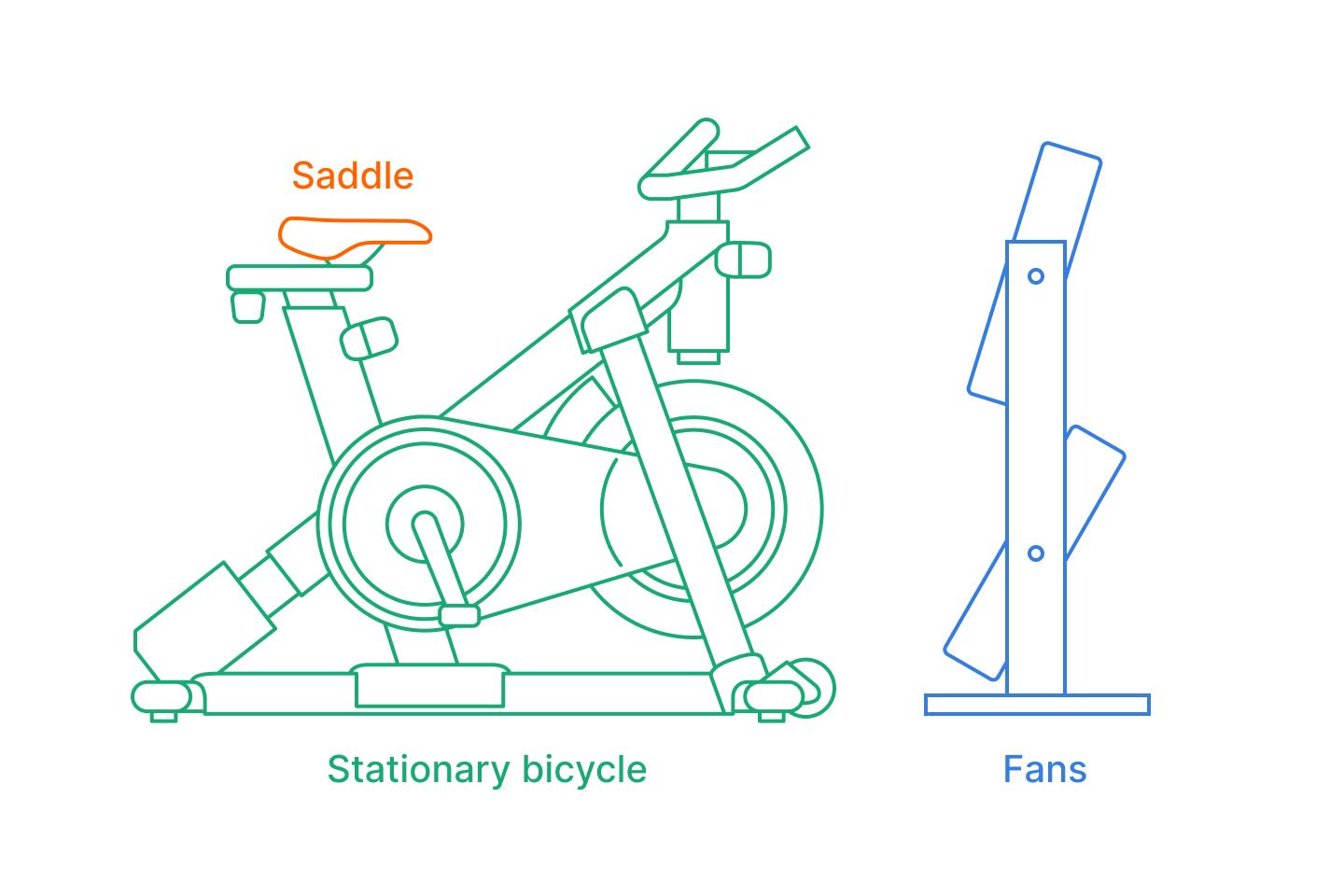
Level two
From here, I planned to use Zwift with the stationary bike while also picking up parts I can later use on a proper outdoor bike. Since my stationary bike has a manual resistance knob, there was no way to let Zwift automatically adjust resistance. However, as long as I can measure power, I could still bike in Zwift.
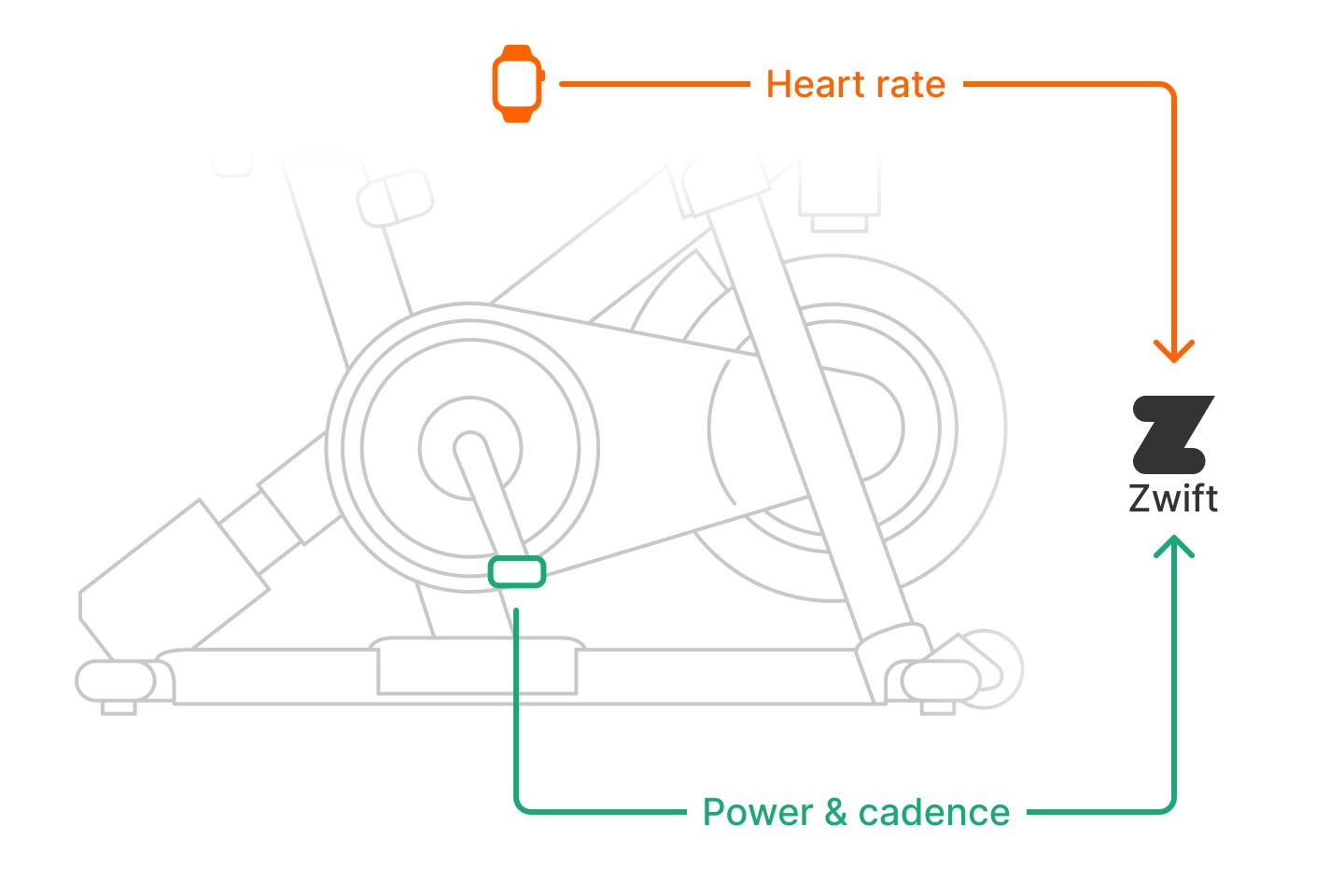
I bought power meter pedals — Garmin Vector 3S (an older version of the RS200 pedals). At $480 used, these are the most expensive component of the entire setup. I opted for these since they are painless to add to any bike, are very accurate, and could be useful if I buy an outdoor bike. If you replace your pedals, note that the left and right pedals thread in opposite directions.
Since the pedals use the Shimano SPD-SL clipless system, I had to find a pair of shoes to match. I bought wide-width Shimano RC3 shoes. They fit my high arches and wide feet well.
For the Zwift device, I hacked together another solution. I stumbled upon an old 30” Apple Cinema HD Display disposed on the street earlier in the year. I found a power supply and the correct USB-C to DVI adapter to get it connected to my M1 MacBook Air. I completed the setup with a stand featuring a shelf to hold the laptop and a VESA mount supporting both monitors and large TVs. I initially thought that 30” would be too small, but it is large enough in practice.
I tried Zwift’s Apple Watch app for heart rate, but I couldn’t get it to work (a known problem). I opted for a cheap optical heart rate monitor (HRM) that I bought lightly used.
I use the Zwift companion app on my iPhone, sitting on the bike’s built-in stand. The companion app connects via Bluetooth to my aforementioned HRM and power meter pedals. It also offers many controls and views that remove my need to touch my computer once I’m riding.
After some longer rides, I still found sitting on the saddle uncomfortable. I remedied that with inexpensive padded bib shorts from The Black Bibs
Total cost at level two: ~$1000 and $15/month for a Zwift subscription
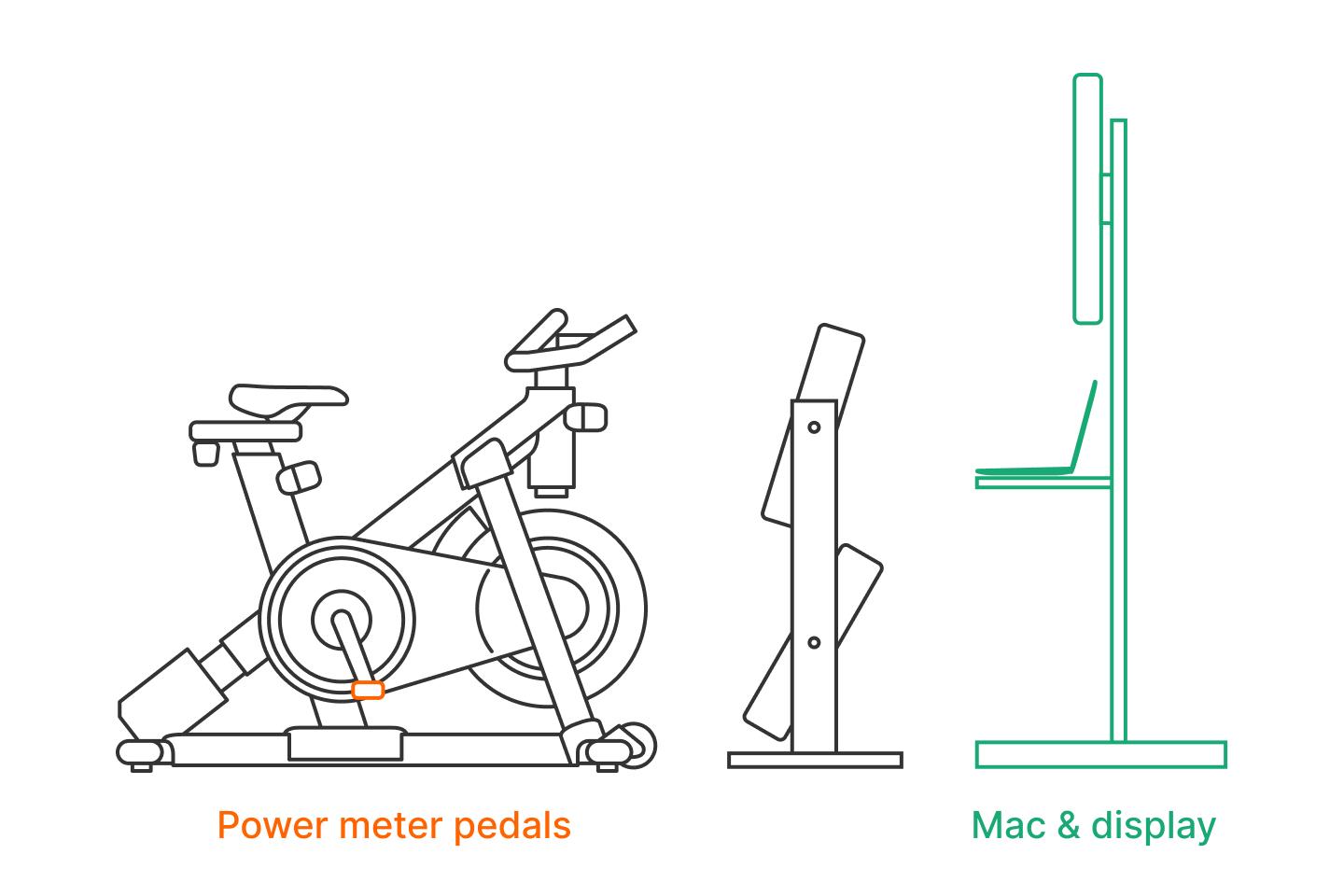
Level three?
Before starting down this journey, I intended to bike outdoors eventually. A month in, I love Zwift so much that I now doubt if I’ll ever buy an outdoor bike. If I do, I’ll have some more research to do as bikes are expensive and hard to come by these days.
My Zwift experience after a month
It has been over a month since my first ride.
At first, I didn’t have drops, Zwift’s in-game currency, and was still level 1. So, I didn’t bother with the shop. Now, I’ve been investing in some in-game gear.
Clothing doesn’t have any effect. Wheels and frames do. They each have a weight and aero rating. Better weight helps on hills, while aero helps at higher speeds down hills and on straights. Since only biking, not real money, unlocks items, Zwift incentivizes improving my real-world health.
My riding has been chiefly free rides to explore Zwift’s many worlds and workouts to improve my fitness. I tried a few competitions and group rides, but I still haven’t got the hang of the dynamics of drafting and staying within the peloton.
I’ve had a lot of fun with the companion app’s camera control and screenshot features. They have let me take some fun photos as if Zwift were a photography game.
Thoughts on my setup
I was skeptical about the resistance knob in place of Zwift-controlled resistance and proper shifting. In practice, I’ve loved it.
The setup requires that I manually adjust the resistance to match a workout or a terrain. It isn’t as realistic as a smart trainer and a bike with shifting, but it is still challenging and engaging.
My results
I’ve logged 883 kilometers and 8,856 meters of elevation gain over 28 hours. An initial FTP test in my first week placed me at 3.0 W/kg. My most recent test was at 3.6 W/kg.
I feel better every day after biking. On occasion, I felt the same runner’s high as during my marathon training days. I’ve noticed quantitive differences as well. My resting heart rate has consistently dropped, and my Apple Watch’s estimate of cardio fitness has gone up.

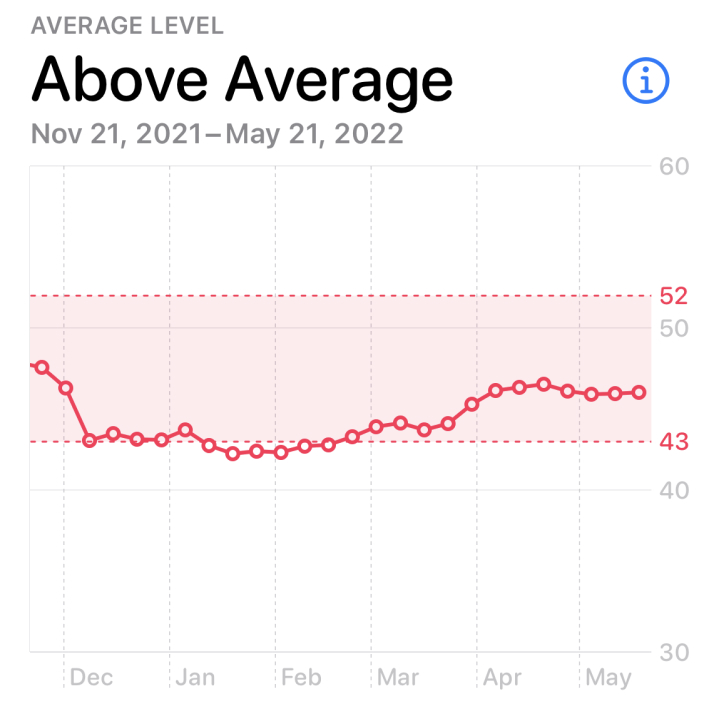
These results are probably also due, in part, to other lifestyle changes like more rest, weight lifting, and a better diet.
What’s next
I love Zwift, and I can’t see myself stopping anytime soon.
I’m honing in on a training plan that balances weight lifting, easy days, long ride days, and hard workouts. I’d love to try a few group rides and maybe even competitions.
I have my eyes set on some of Zwift’s built-in challenges as well. I will soon finish the initial bit of the Everest challenge and unlock a fantastic in-game bike.
Also, in a funny turn of events, a stretching routine has solved the foot issue that prevented me from running.
So, now I can run again, but I’m not motivated to anymore. Cycling on Zwift is more fun and time-efficient since I can walk to my garage and bike in minutes. There are no traffic lights to wait for and no weather to account for.
I’ll see you on Zwift!
Thanks to Q for reading drafts of this.
